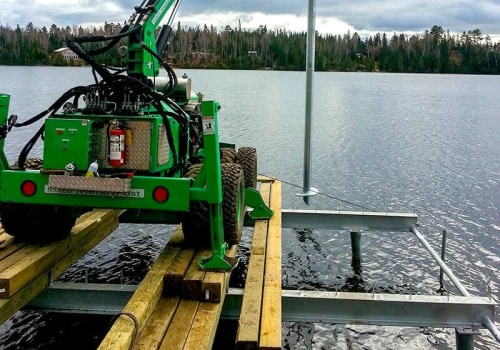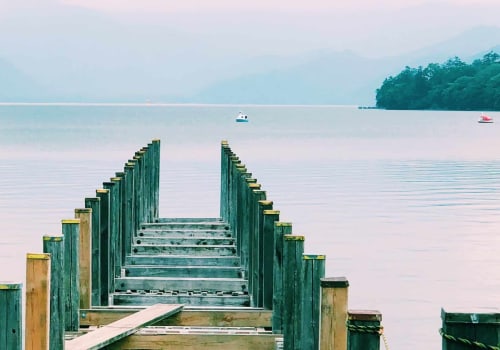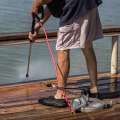Are you looking to build a floating dock, but unsure about how to properly anchor it? Look no further! In this comprehensive guide, we will walk you through everything you need to know about pile anchoring for building, installing, and maintaining a floating dock. Whether you're a first-time dock owner or a seasoned veteran, this article will provide valuable information and tips for making sure your dock stays secure and functional. So let's dive in and learn all about the important role of pile anchoring in the design of a floating dock!Firstly, let's define what pile anchoring is.
Pile anchoring
is a method of securing a floating dock in place by driving piles into the ground below the water's surface.These piles act as sturdy support structures for the dock, keeping it stable and anchored in place. Now that we have a basic understanding of pile anchoring, let's dive into the details. When it comes to building a floating dock, one of the first things to consider is the type of material you will be using. Piles can be made of wood, concrete, steel, or even plastic.
Each material has its own set of advantages and disadvantages, so it's important to weigh your options carefully. For example, wood piles are cost-effective but may require more maintenance in the long run compared to concrete or steel piles. Next, we'll discuss the installation process of pile anchoring. It's crucial to ensure that the piles are properly driven into the ground at the right depth and angle for maximum stability.
This step requires specialized equipment and expertise, so it's best to hire a professional dock builder for this task. They will also be able to advise you on the appropriate spacing and number of piles needed for your specific dock design. Once the floating dock is installed, regular maintenance is necessary to ensure its longevity and safety. This includes inspecting the piles for any damage, checking for any signs of shifting or movement, and replacing any worn or damaged hardware.
It's also important to keep the area around the piles clear of debris and marine growth to prevent any potential damage or deterioration. Now that you have a good understanding of pile anchoring, let's explore some design ideas for floating docks. You can choose from a variety of shapes, sizes, and layouts to suit your needs and preferences. Some popular options include T-docks, L-docks, and U-shaped docks.
You can also incorporate features like gangways, cleats, and bumpers to make your dock even more functional and versatile. Finally, let's talk about cost considerations for building a floating dock with pile anchoring. The overall cost will depend on several factors such as the size of your dock, the materials used, and the complexity of the installation. It's best to consult with a professional dock builder for an accurate estimate and to discuss any cost-saving options that may be available.
Design Ideas for Your Dream Dock
When it comes to designing your dream dock, the options are endless.Pile anchoring allows for flexibility in layout and features, making it the perfect choice for your floating dock. One design idea to consider is incorporating different levels on your dock. This can provide more space for seating areas, storage, or even a small entertainment area. Another idea is to add a roof or awning to provide shade and protection from the elements. This is especially useful if you plan on spending long days on your dock. If you have a larger boat or multiple watercrafts, you may want to consider adding a slip or ramp onto your dock for easy access.
This can also be helpful for those with disabilities or mobility limitations. For those looking for a more luxurious dock, adding features such as a built-in grill or outdoor kitchen, a hot tub, or even a small beach area can take your dock to the next level. With pile anchoring, you have the freedom to create the dock of your dreams.
Maintaining Your Floating Dock for Longevity
Proper maintenance is crucial for keeping your floating dock in top condition and extending its lifespan. By following a few simple tasks and precautions, you can ensure that your dock stays strong and sturdy for years to come. First and foremost, regular inspections are key to identifying any potential issues before they become major problems. Inspect the structural integrity of your dock, as well as the connections and fastenings.Look for any signs of wear and tear, such as rust or corrosion, and address them immediately. Additionally, it's important to regularly clean your dock to prevent buildup of debris and algae. Use a mild detergent and soft-bristled brush to gently scrub the surface of your dock. This will not only keep it looking clean and presentable, but also prevent any potential damage from buildup over time. Another important aspect of maintenance is ensuring proper anchoring. Make sure that your dock is securely anchored to the bottom using the appropriate pile anchors.
Check the anchors regularly to make sure they are still properly attached and functioning as they should be. Finally, be mindful of any extreme weather conditions that may affect your dock. In areas prone to hurricanes or strong winds, consider investing in additional anchoring or temporary measures to protect your dock during these events.
Proper Installation Techniques for Maximum Stability
When it comes to building a floating dock, proper installation techniques are crucial for achieving maximum stability. It is highly recommended to hire a professional dock builder for the installation process. They have the expertise and experience to ensure that your dock is installed correctly and securely. One of the main reasons to hire a professional is to avoid any potential mistakes that could compromise the stability of your dock.A poorly installed dock can lead to safety hazards and costly repairs in the future. A professional dock builder will also have the necessary equipment and tools to properly anchor the piles and secure the dock in place. Another important aspect of proper installation is choosing the right location for your dock. This involves considering factors such as water depth, current, and wind conditions. A professional dock builder will be able to assess these factors and choose the optimal location for your dock. To further ensure stability, there are some tips you can follow during the installation process.
First, make sure that the piles are driven deep enough into the ground. The deeper the piles, the more stable the dock will be. Additionally, using cross-bracing between piles can provide extra support and prevent shifting or tilting of the dock. It is also important to regularly inspect and maintain your dock after installation. This can help identify any potential issues early on and prevent them from becoming major problems.
Overall, hiring a professional dock builder and following these tips for installation can greatly contribute to the stability and longevity of your floating dock.
Choosing the Right Material for Your Piles
use HTML structure with pile anchoring only for main keywords and When it comes to building a floating dock, choosing the right material for your piles is crucial for its durability and longevity. Pile anchoring is the foundation of your dock, supporting the weight of your boat or watercraft and withstanding the constant movement of the water. Here are some factors to consider when deciding on the type of material for your piles:- Water Conditions: The type of water your dock will be in plays a big role in determining the material for your piles. If you are in a freshwater environment, pressure-treated wood or composite materials may be suitable.
However, if you are in a saltwater environment, you will need to opt for a more corrosion-resistant material such as galvanized steel or concrete.
- Budget: Another important factor to consider is your budget. Some materials may be more expensive than others, so it's essential to assess how much you are willing to spend on your dock before deciding on the material for your piles.
- Dock Design: The design and layout of your dock can also impact the type of material you choose for your piles. If you have a larger or heavier boat, you may need stronger and more durable materials such as steel or concrete piles.
Cost Considerations for Building a Floating Dock
When it comes to building a floating dock, one of the most important factors to consider is the cost.The cost of building a floating dock can vary greatly depending on a variety of factors. In this section, we will discuss the different factors that can affect the overall cost of building a floating dock and potential cost-saving options.
Size and Materials
The size of your floating dock and the materials you choose to use will have a significant impact on the overall cost. Larger docks and those made with more expensive materials, such as wood or composite decking, will naturally cost more than smaller docks made with less expensive materials like plastic or aluminum.Location and Accessibility
The location of your dock can also affect its cost. If your dock is located in a remote or hard-to-access area, it may require additional time and resources to build, which can increase the overall cost.Similarly, if your dock is in an area with rough or unpredictable water conditions, you may need to invest in stronger and more expensive materials to ensure its stability, which can also add to the cost.
Labor and Equipment
The labor and equipment required to build your floating dock will also contribute to the overall cost. If you are hiring a professional contractor, their rates and fees will vary depending on their experience and location. Additionally, if special equipment is needed for the construction process, such as barges or cranes, this can also add to the overall cost.DIY Options
One potential cost-saving option for building a floating dock is to do it yourself. If you have experience in construction and access to the necessary tools and materials, building your own dock can significantly reduce the overall cost.However, it is important to note that building a dock can be a complex and time-consuming process, so it may not be suitable for everyone.
Considerations for Maintenance
In addition to the initial cost of building a floating dock, it is important to also consider the cost of maintenance. Depending on the materials used and the location of your dock, you may need to invest in regular maintenance, such as cleaning, sealing, or repairs, to ensure its longevity. This should be factored into your overall cost considerations when planning your dock construction. Building a floating dock with pile anchoring may seem like a daunting task, but with the information provided in this article, you now have the knowledge to make informed decisions. From choosing the right materials to maintaining your dock, pile anchoring is key to achieving a safe and functional floating dock.Don't hesitate to consult with a professional dock builder for expert advice and assistance in bringing your dream dock to life.






